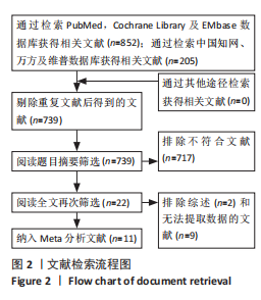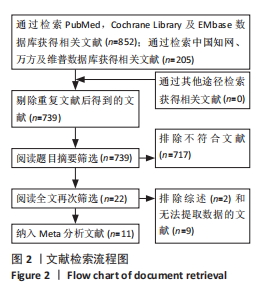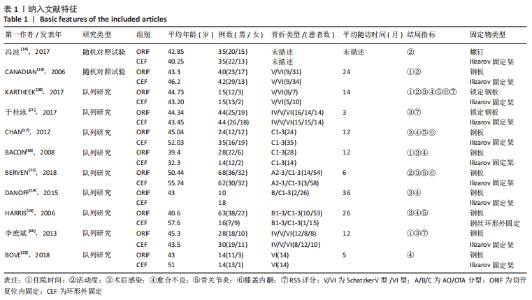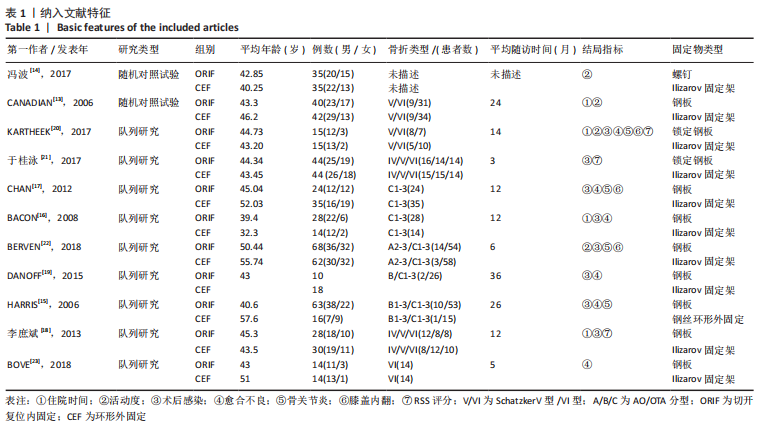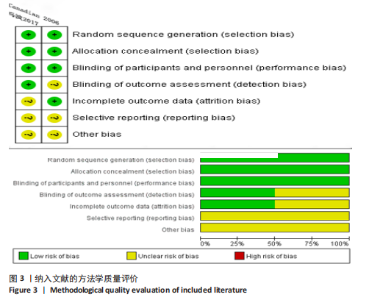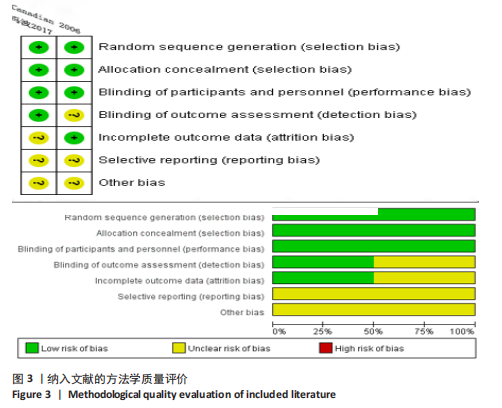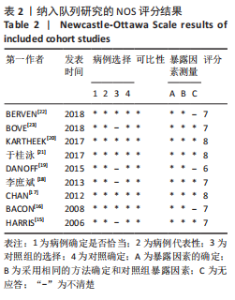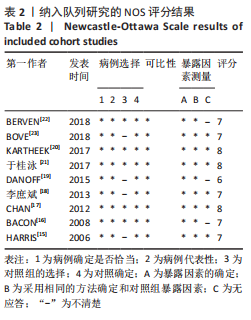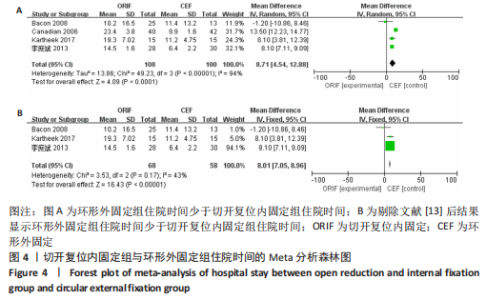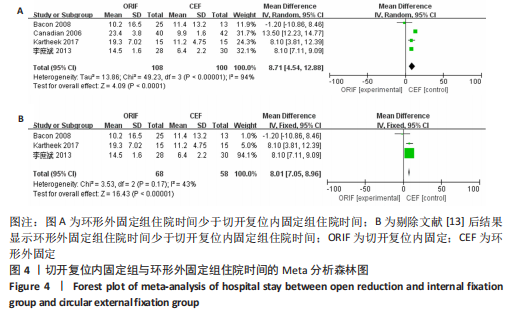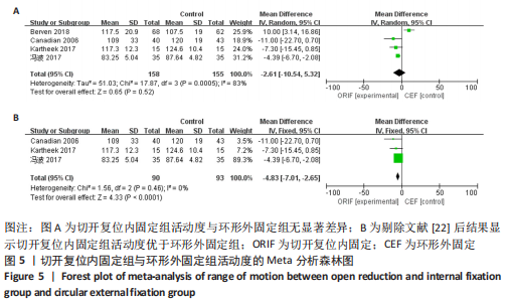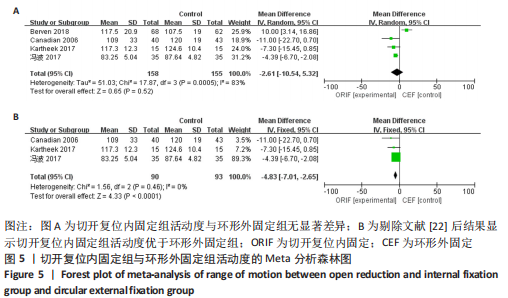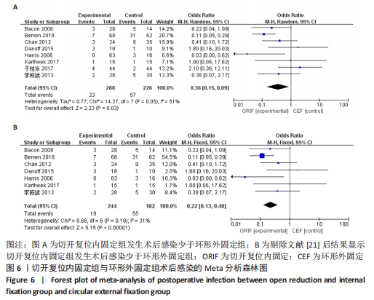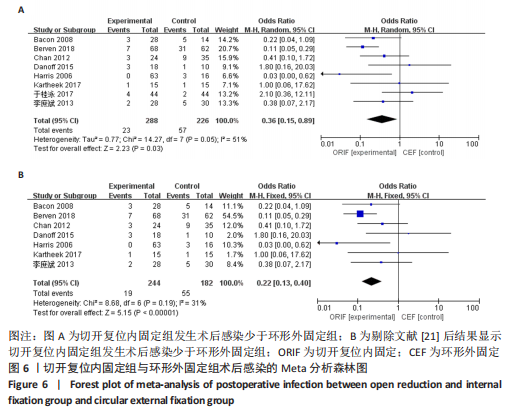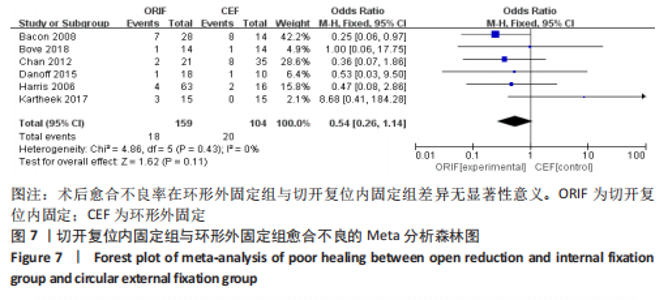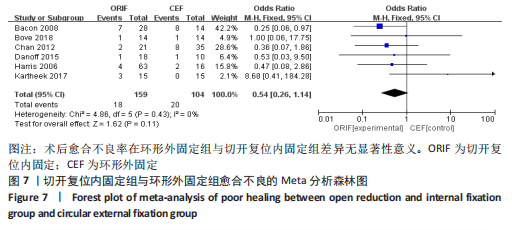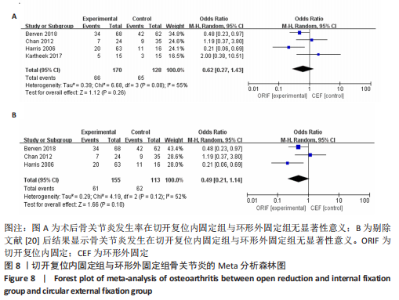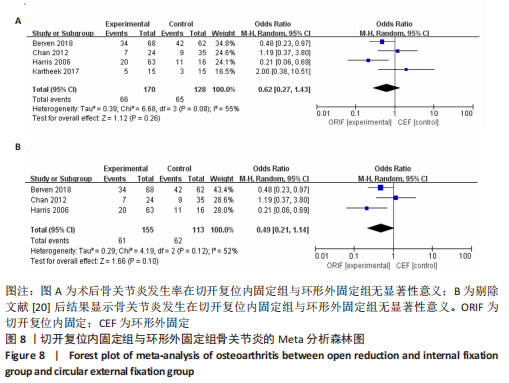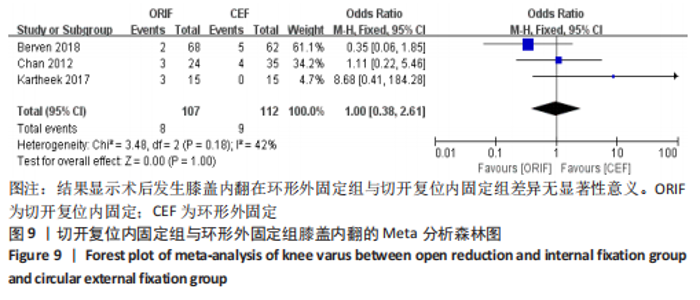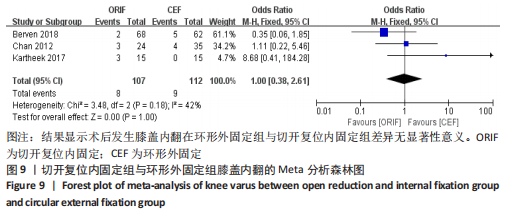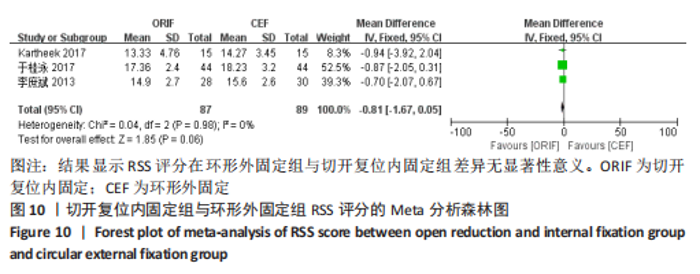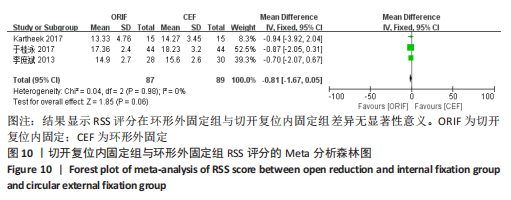Chinese Journal of Tissue Engineering Research ›› 2022, Vol. 26 ›› Issue (3): 480-486.doi: 10.12307/2022.079
Previous Articles Next Articles
Open reduction and internal fixation versus circular external fixation for tibial plateau fractures: a meta-analysis
Yang Ruijia1, 2, Jiang Lingkai1, Dong Zhengquan1, Wang Yunfei1, Ma Zhou1, Cong Linlin1, 2, Guo Yanjing1, 2, Gao Yangyang1, Li Pengcui1
- 1Laboratory of Orthopedics, Second Hospital of Shanxi Medical University, Taiyuan 030001, Shanxi Province, China; 2Department of Biochemistry and Molecular Biology, Shanxi Medical University, Taiyuan 030001, Shanxi Province, China
-
Received:2020-12-07Revised:2020-12-12Accepted:2021-02-07Online:2022-01-28Published:2021-10-29 -
Contact:Li Pengcui, MD, Chief physician, Laboratory of Orthopedics, Second Hospital of Shanxi Medical University, Taiyuan 030001, Shanxi Province, China -
About author:Yang Ruijia, Master candidate, Technician, Laboratory of Orthopedics, Second Hospital of Shanxi Medical University, Taiyuan 030001, Shanxi Province, China; Department of Biochemistry and Molecular Biology, Shanxi Medical University, Taiyuan 030001, Shanxi Province, China -
Supported by:the National Natural Science Foundation of China, No. 81772415 (to WL)
CLC Number:
Cite this article
Yang Ruijia, Jiang Lingkai, Dong Zhengquan, Wang Yunfei, Ma Zhou, Cong Linlin, Guo Yanjing, Gao Yangyang, Li Pengcui. Open reduction and internal fixation versus circular external fixation for tibial plateau fractures: a meta-analysis[J]. Chinese Journal of Tissue Engineering Research, 2022, 26(3): 480-486.
share this article
Add to citation manager EndNote|Reference Manager|ProCite|BibTeX|RefWorks
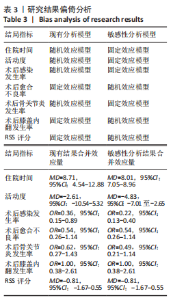
2.3.8 敏感性分析结果汇总 通过改变纳入文献合并效应统计分析模型,对上述研究进行了敏感性分析,见表3。 接受环形外固定组比切开复位内固定组更容易出现术后感染,在分析过程中纳入的8个研究异质性较大[15-22],在剔除引起异质性的文献后异质性显著降低[21],引起该异质性的原因可能是因为该文献仅统计了软组织感染的患者,与其他录入的研究之间纳入统计的标准不同,但剔除该文献前后的结果均有显著性意义,提示结果稳定。切开复位内固定组的术后活动度优于环形内固定组,在纳入文献分析过程中有4个研究异质性较大[13-14,20,22],在剔除引起异质性的文献异质性显著降低[13],该文献引起异质性的原因可能是,在该文献中在术前对各组骨折移位和损伤程度进行评估再进行分组,这与其他纳入的文献的分组方式存在差异,损伤程度的不同最终导致的活动度也存在一定差异,这可能是造成异质性最主要的原因。另外,环形外固定组手术时间比切开复位内固定组住院时间少,分析过程中纳入4个研究异质性较大[13,16,18,20],在剔除引起异质性的文献异质性明显降低[13],该文献引起异质性的原因可能是,研究中环形外固定有2例病例在手术过程中,采用了与其他不相同的手术方式,这可能是异质性产生的原因,该结果也存在纳入病例少的问题,更可靠的结果还需进一步纳入更多的临床病例。 "
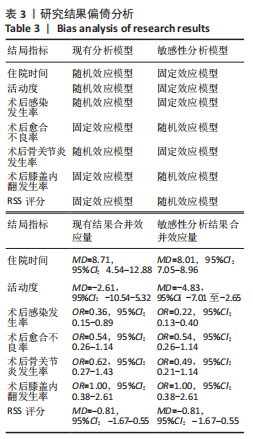
| [1] LI J, ZHU Y, ZHAO K, et al. Incidence and risks for surgical site infection after closed tibial plateau fractures in adults treated by open reduction and internal fixation: a prospective study. J Orthop Surg Res. 2020;15(1):349. [2] METCALFE D, HICKSON C, MCKEE L, et al. External versus internal fixation for bicondylar tibial plateau fractures: systematic review and meta-analysis. J Orthop Traumatol. 2015; 16(4):275-285. [3] BOUTEFNOUCHET T, LAKDAWALA A, MAKRIDES P. Outcomes following the treatment of bicondylar tibial plateau fractures with fine wire circular frame external fixation compared to open reduction and internal fixation: a systematic review. J Orthop. 2015;13(3):193-199. [4] JANSEN H, FREY S, DOHT S, et al. Medium-term results after complex intra-articular fractures of the tibial plateau. J Orthop Sci. 2013;18(4):569-577. [5] DENDRINOS G, KONTOS S, KATSENIS D, et al. Treatment of high-energy tibial plateau fractures by the Ilizarov circular fixator. J Bone Joint Surg Br. 1996;78(5):710-717. [6] PUGH K, WOLINSKY P, MCANDREW M, et al. Tibial pilon fractures: a comparison of treatment methods. J Trauma. 1999;47(5):937-941. [7] BONATO L, EDWARDS E, GOSLING C, et al. Patient reported health related quality of life early outcomes at 12 months after surgically managed tibial plafond fracture. Injury. 2017; 48(4):946-953. [8] VASILIADIS E, GRIVAS T, PSARAKIS S, et al. Advantages of the Ilizarov external fixation in the management of intra-articular fractures of the distal tibia. J Orthop Surg Res. 2009;4:35. [9] 卓乃强,李正疆,葛建华,等.内固定与外支架固定治疗复杂性胫骨平台骨折的对比研究[J].中国修复重建外科杂志,2008, 22(8):952-955. [10] BRYSON W, FISCHER E, JENNINGS J, et al. Three-column classification system for tibial plateau fractures: what the orthopedic surgeon wants to know. Radiographics. 2020;41(1): 144-155. [11] STANG A. Critical evaluation of the Newcastle-Ottawa scale for the assessment of the quality of nonrandomized studies in meta-analyses. Eur J Epidemiol. 2010;25(9):603-605. [12] CUMPSTON M, LI T, PAGE M, et al. Updated guidance for trusted systematic reviews: a new edition of the Cochrane Handbook for Systematic Reviews of Interventions. Cochrane Database Syst Rev. 2019;10:ED000142. [13] SOCIETY COT. Open reduction and internal fixation compared with circular fixator application for bicondylar tibial plateau fractures. Results of a multicenter, prospective, randomized clinical trial. J Bone Joint Surg Am. 2006;88(12):2613-2623. [14] 冯波.切开复位内固定与Ilizarov外固定治疗胫骨平台骨折的效果对比分析[J].医学理论与实践,2017,30(14):2104-2105. [15] HARRIS A, PATTERSON B, SONTICH J, et al. Results and outcomes after operative treatment of high-energy tibial plafond fractures. Foot Ankle Int. 2006;27(4):256-265. [16] BACON S, SMITH W, MORGAN S, et al. A retrospective analysis of comminuted intra-articular fractures of the tibial plafond: Open reduction and internal fixation versus external Ilizarov fixation. Injury. 2008;39(2):196-202. [17] CHAN C, KEATING J. Comparison of outcomes of operatively treated bicondylar tibial plateau fractures by external fixation and internal fixation. Malays Orthop J. 2012;6(1):7-12. [18] 李庶斌,郭卫东,赵宗峤.内固定与环形外固定架治疗闭合性胫骨平台骨折的对比研究[J].中国矫形外科杂志,2013,21(24):2455-2459. [19] DANOFF J, SAIFI C, GOODSPEED D, et al. Outcome of 28 open pilon fractures with injury severity-based fixation. Eur J Orthop Surg Traumatol. 2015;25(3):569-575. [20] KARTHEEK RP KK. Ilizarov and locking plate fixation for closed bicondylar tibial plateau fracturesa prospective study. J. Evolution Med. 2017;6(64):4670-4675. [21] 于桂泳,赵志明,刘鹏,等.钢板固定与环形外固定架治疗闭合性胫骨平台骨折及对软骨细胞凋亡的影响研究[J].中华保健医学杂志,2017,19(6):519-523. [22] BERVEN H, BRIX M, IZADPANAH K, et al. Comparing case-control study for treatment of proximal tibia fractures with a complete metaphyseal component in two centers with different distinct strategies: fixation with Ilizarov frame or locking plates. J Orthop Surg Res. 2018;13(1):121. [23] BOVE F, SALA F, CAPITANI P, et al. Treatment of fractures of the tibial plateau (Schatzker VI) with external fixators versus plate osteosynthesis. Injury. 2018;49 Suppl 3:S12-S18. [24] MAUFFREY C, VASARIO G, BATTISTON B, et al. Tibial pilon fractures: a review of incidence, diagnosis, treatment, and complications. Acta Orthop Belg. 2011;77(4):432-440. [25] 张小龙,李皓桓.胫骨平台骨折的手术治疗[J].生物骨科材料与临床研究,2017,14(4):58-62. [26] MALIK-TABASSUM K, PILLAI K, HUSSAIN Y. Post-operative outcomes of open reduction and internal fixation versus circular external fixation in treatment of tibial plafond fractures: a systematic review and meta-analysis. Injury. 2020;51(7):1448-1456. [27] 王浩磊,郑永茂,柴充.环形外固定治疗复杂胫骨平台骨折的临床疗效观察[J].中华骨与关节外科杂志,2017,10(3):240-242. [28] BIGGI F, DI FABIO S, D’ANTIMO C, et al. Tibial plateau fractures: internal fixation with locking plates and the MIPO technique. Injury. 2010;41(11):1178-1182. [29] TEENY S, WISS D, RESEARCH R. Open reduction and internal fixation of tibial plafond fractures. Variables contributing to poor results and complications. Clin Orthop Relat Res. 1993; (292):108-117. [30] RUFFOLO M, GETTYS F, MONTIJO H, et al. Complications of high-energy bicondylar tibial plateau fractures treated with dual plating through 2 incisions. J Orthop Trauma. 2015;29(2):85-90. [31] BALOCH S, RAFI M, JUNAID J, et al. Ilizarov fixation method of tibia plateau fractures: a prospective observational study. Cureus. 2020;12(10):e11277. [32] BERTRAND M, PASCUAL-LóPEZ F, GUERADO EJI. Severe tibial plateau fractures (Schatzker V-VI): open reduction and internal fixation versus hybrid external fixation. Injury. 2017;48 Suppl 6:S81-S85. [33] TAHIR M, KUMAR S, SHAIKH S, et al. Comparison of postoperative outcomes between open reduction and internal fixation and ilizarov for schatzker type V and type VI fractures. Cureus. 2019;11(6):e4902. [34] ZHAO X, MA J, MA X, et al. A meta-analysis of external fixation versus open reduction and internal fixation for complex tibial plateau fractures. Int J Surg. 2017;39:65-73. |
| [1] | Jing Jinpeng, Zhang Yue, Liu Xiaomin, Liu Yi. Traditional Chinese medicine injection for promoting blood circulation in prevention of deep vein thrombosis after orthopedic surgery: network meta-analysis [J]. Chinese Journal of Tissue Engineering Research, 2022, 26(9): 1467-1476. |
| [2] | Yuan Jiabin, Zhu Zongdong, Tang Xiaoming, Wei Dan, Tan Bo, Xiao Chengwei, Zhao Ganlinwei, Liao Feng. Classification and reduction strategies for irreducible intertrochanteric femoral fracture based on anatomy [J]. Chinese Journal of Tissue Engineering Research, 2022, 26(9): 1341-1345. |
| [3] | Pan Baoshun, Fang Zhen, Gao Mingjie, Fang Guiming, Chen Jinshui. Design for posterior atlantoaxial internal fixation system with fusion cage based on imaging data [J]. Chinese Journal of Tissue Engineering Research, 2022, 26(9): 1372-1376. |
| [4] | Li Kun, Gao Erke, Xiong Feng, Wang Xing, Wu Danqi, Li Zhijun, Zhang Shaojie, Liu Yanan, Duo Lan, Li Ziyu. Feasibility of axial transpedicle screw internal fixation in children aged 1 to 6 years [J]. Chinese Journal of Tissue Engineering Research, 2022, 26(9): 1383-1387. |
| [5] | Jiang Huanchang, Zhang Zhaofei, Liang De, Jiang Xiaobing, Yang Xiaodong, Liu Zhixiang. Comparison of advantages between unilateral multidirectional curved and straight vertebroplasty in the treatment of thoracolumbar osteoporotic vertebral compression fracture [J]. Chinese Journal of Tissue Engineering Research, 2022, 26(9): 1407-1411. |
| [6] | Zhuang Zhikun, Wu Rongkai, Lin Hanghui, Gong Zhibing, Zhang Qianjin, Wei Qiushi, Zhang Qingwen, Wu Zhaoke. Application of stable and enhanced lined hip joint system in total hip arthroplasty in elderly patients with femoral neck fractures complicated with hemiplegia [J]. Chinese Journal of Tissue Engineering Research, 2022, 26(9): 1429-1433. |
| [7] | Liu Gang, Ma Chao, Wang Le, Zeng Jie, Jiao Yong, Zhao Yi, Ren Jingpei, Hu Chuanyu, Xu Lin, Mu Xiaohong. Ankle-foot orthoses improve motor function of children with cerebral palsy: a Meta-analysis based on 12 randomized controlled trials [J]. Chinese Journal of Tissue Engineering Research, 2022, 26(8): 1299-1304. |
| [8] | Yang Jun, Yang Qun, Zhang Rui, Jiang Chang. A novel slidable pedicle screw-rod system for lumbar tuberculosis: promoting bone graft fusion by producing stress stimulation to fused segment [J]. Chinese Journal of Tissue Engineering Research, 2022, 26(6): 914-918. |
| [9] | Zhang Xinlong, Ci Wentao, Luo Kaiwen, Yan shi. Internal fixation failure after proximal femoral nail antirotation: causes and reoperation strategies [J]. Chinese Journal of Tissue Engineering Research, 2022, 26(6): 973-979. |
| [10] | Liu Yiyi, Qiu Junqiang, Yi Longyan, Zhou Cailiang. Effect of resistance training on interleukin-6 and C-reactive protein in middle-age and elderly people: a Meta-analysis [J]. Chinese Journal of Tissue Engineering Research, 2022, 26(5): 804-812. |
| [11] | Wang Nan, Qian Yuzhang, Xie Lin. Network Meta-analysis of different acupuncture methods for the treatment of lumbar disc herniation [J]. Chinese Journal of Tissue Engineering Research, 2022, 26(5): 813-820. |
| [12] | Shen Song, Xu Bin. Diffuse distribution of bone cement in percutaneous vertebroplasty reduces the incidence of refracture of adjacent vertebral bodies [J]. Chinese Journal of Tissue Engineering Research, 2022, 26(4): 499-503. |
| [13] | Wei Zhoudan, Li Wenjin, Zhu Li, Wang Yu, Zhao Jiaoyang, Chen Yanan, Guo Dong, Hao Min. Platelet-rich fibrin as a material for alveolar ridge preservation significantly reduces the resorption of alveolar bone height and width after tooth extraction: a meta-analysis [J]. Chinese Journal of Tissue Engineering Research, 2022, 26(4): 643-648. |
| [14] | Ou Liang, Kong Dezhong, Xu Daoqing, Ni Jing, Fu Xingqian, Huang Weichen. Comparative clinical efficacy of polymethyl methacrylate and self-solidifying calcium phosphate cement in vertebroplasty: a meta-analysis [J]. Chinese Journal of Tissue Engineering Research, 2022, 26(4): 649-656. |
| [15] | Cai Feng, Yu Bo, Zeng Duo, Chen Qincan, Liao Qi. Cortical bone trajectory in elderly patients with osteoporosis of lumbar disease [J]. Chinese Journal of Tissue Engineering Research, 2022, 26(3): 403-407. |
| Viewed | ||||||
|
Full text |
|
|||||
|
Abstract |
|
|||||
